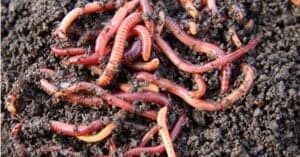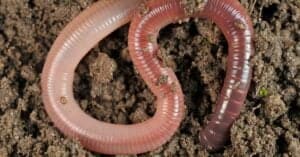Do you need a multi-purpose feeder insect? Then you should learn how to raise wax worms.
Pet reptiles, amphibians, small mammals, and even certain birds can be fed with wax worms. Whether you’re looking to satiate a hungry bearded dragon or provide a meal to an adorable hedgehog, wax worms can do the trick.
Wax worms belong to the Pyralidae family and live throughout the world. They aren’t expensive to purchase and incredibly easy to care for.
What do wax worms eat? Read on to find out.
What Do Wax Worms Eat?
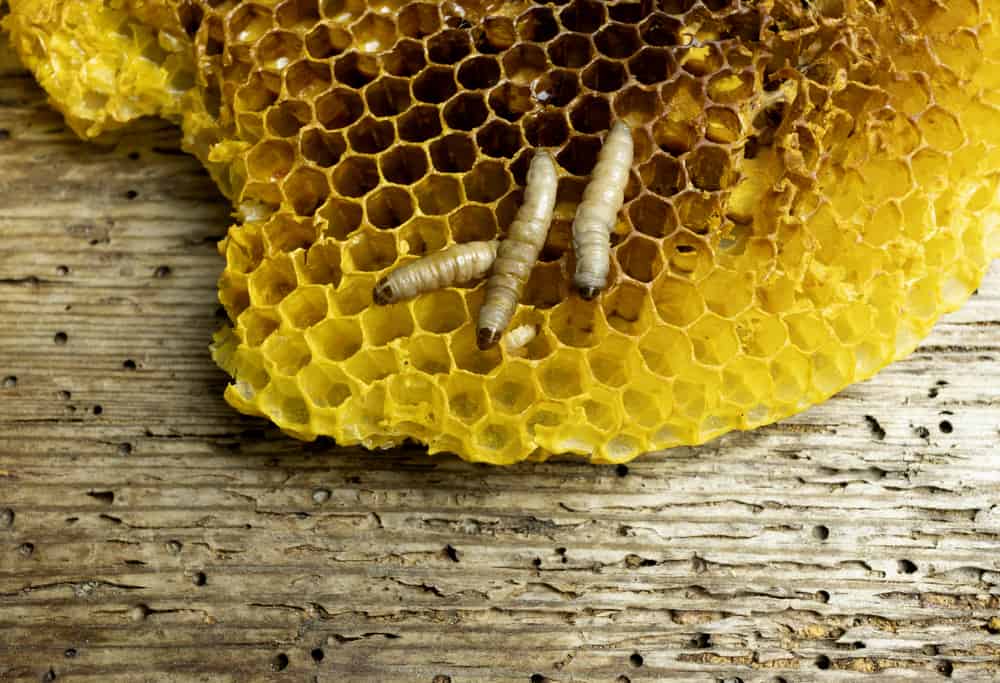
Wax worms eat the pollen, beeswax, shed bee skins, and cocoons found in honeycomb.
©Sendo Serra/Shutterstock.com
Wax worms eat pollen, beeswax, shed bee skins, and cocoons. What do wax worms eat in captivity? Captive wax worms can live off of a diet of honey, bran, and grain cereal. Their captive diet is similar to the foods mealworms and super worms eat.
In the wild, wax worms feed on the wax that bees use to build their honeycomb. To become full-grown adults, wax worms need protein from brood comb.
The proteins from the brood comb or brood cell cleanings help the larvae completely develop. In captivity, a wax worm can go a long time without eating. They can go even longer without eating if you keep them at a cool temperature.
What Do Wax Worms Drink?
Wax worms don’t need to drink water. The honey provided in their diet includes plenty of hydration. As long as you’re storing your wax rooms at a cool temperature, they can go days without eating anything.
How to Care For Wax Worms

Wax moths make great feeder insects.
©murat photographer/Shutterstock.com
Wax worms must be kept at a cool temperature of 55 to 60° F. The cool temperatures help the wax worms remain dormant, which means they can last several weeks.
You should avoid storing your wax worms in a refrigerator since it’ll probably be too cold. If you must use the refrigerator, keep the worms in the fridge door. The door tends to be a little bit warmer, which can help keep your wax worms alive. If you have a wine cooler, that can also be the perfect place for storing wax worms.
It’s essential to keep these worms at low humidity. If the bedding feels moist at any time, replace it with dry bedding immediately.
Even when you provide the ideal environment, some wax worms will die. It’s essential to clear out the dead wax worms every day. The dead worms will be easy to spot since they usually turn black.
Where to House Wax Worms
You can store wax worms in the same container you receive them in. If you decide to transfer them to a new container, you’ll want a plastic tub with a secure cover.
If the wax worms turn into wax moths, ensure you keep the container covered at all times. Allowing the moths to fly throughout your home could cause an infestation.
For ventilation, you’ll want to punch small holes in the container. You could also create a window with a mesh opening and hot glue. Good ventilation is a must since wax worms require low humidity.
How to Feed Wax Worms
You don’t need to feed your wax worms. When they’re hungry, they’ll stock up on nutrients. As long as you have the right type of foods available in their enclosure, your wax rooms will get all of the nutrients they need.
What foods should you use for a wax worm recipe? Here are the best ingredients:
- Wheat cereal
- Barley baby cereal
- Oats cereal
- Liquid glycerin
- Honey
- Multivitamin powder
- Calcium powder
Baby cereals work best. After picking a cereal, add enough honey to make the mixture moist. Add a little bit of liquid glycerin to moisten things up even more.
The mixture should be able to form a ball without being too wet. Add in a tiny amount of vitamin powder and calcium in equal quantities. Less is better when it comes to adding supplements.
The liquid glycerin will help keep the food from drying out too fast. Your wax worms will be able to get all of the water and nutrients they need from this honey-filled food mixture.
How Long Do Wax Worms Live?
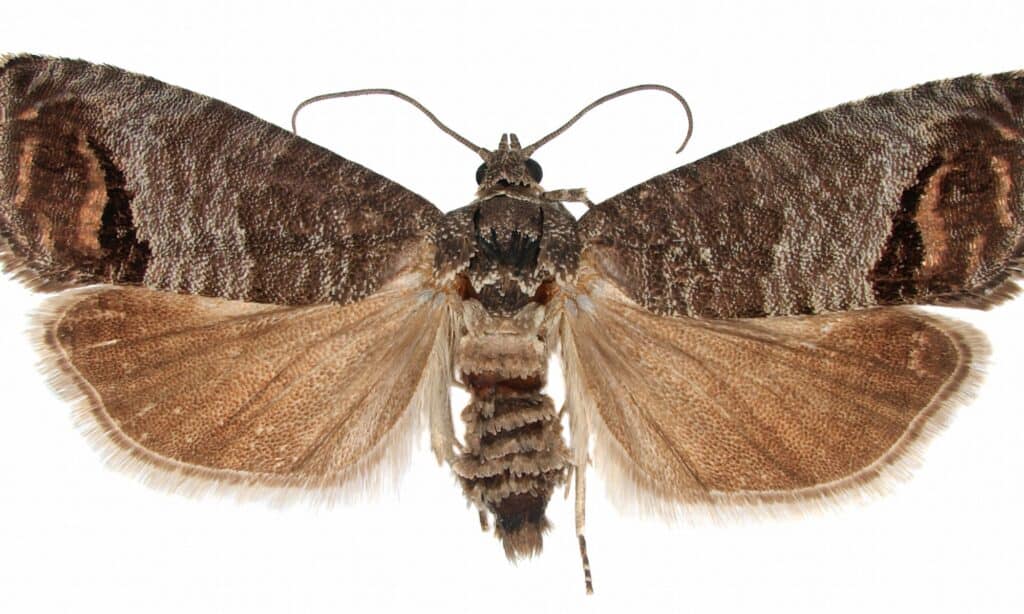
Wax worms turn into moths within 1-2 weeks.
©iStock.com/Tomasz Klejdysz
Wax worms live from 1 to 3 weeks. The caterpillar larva will turn into wax moths if left to their own devices.
What do wax worms eat in the classroom? The same food as insect feeders. However, you’ll want to keep the worms a little warmer.
By creating a hotspot in the room where the cups of wax worms can sit, the worms will be able to progress through the developmental stages faster. After patiently waiting, students will get to see the tiny larva emerge as wax moths.
Wax Moth Mating
When adult wax moths emerge, they can go in jars for mating. Make sure the jar has a ventilated lid. Students will be able to continue watching the life cycle of wax worms as they mate and lay eggs. The food recipe for the wax worms can feed the adult wax moths.
Can Wax Worms Reduce Plastic Pollution?
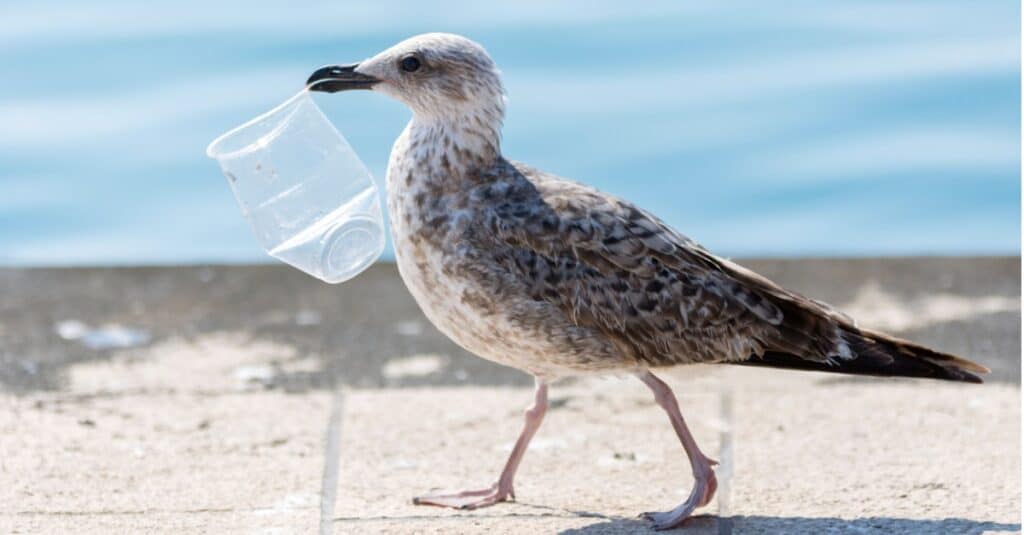
Wax worms can help clean up plastic pollution.
©iStock.com/Robert Pleško
Every year the world produces millions of tons of plastic. A lot of this plastic is polluting our planet rather than being recycled.
Wax worms can eat plastic bags. This begs the question, could these larvae help save our planet?
A wax worm has the powerful ability to chew through the plastic at a fast rate. Their physiology gives them the ability to break down plastic. Similar to how they break down beeswax, they can work their way through all sorts of plastic materials.
Polyethylene PE is one of the most problematic plastics, and it isn’t biodegradable. However, researchers are discovering wax worms can chew through PE with ease.
Both beeswax and plastic are polymers that use similar chemical bonds. It’s still unclear if the wax worm uses enzymes from their skin or microbes from their gut to break down the materials.
Plastic doesn’t provide enough nutrition for the worms to live on. To help with ethical issues, manufacturers consider adding nutrients to the plastics before feeding them to wax worms.
Wax rooms aren’t the only worms that can biodegrade certain types of plastic. Mealworms are also known for their ability to break down foam.
The photo featured at the top of this post is © murat photographer/Shutterstock.com
Thank you for reading! Have some feedback for us? Contact the AZ Animals editorial team.




